The Four Castes of Honey Bees: Exploring the Complex Social Structure Honey bees (Apis mellifera) are well-known for their intricate social organization, with different castes of bees performing specific roles within the colony. While many people are familiar with the concept of worker bees and queen bees, the honey bee colony actually consists of four distinct castes: queens, workers, drones, and virgin queens. Each caste has unique characteristics and responsibilities that contribute to the survival and success of the colony. In this comprehensive guide, we will delve into the fascinating world of these four honey bee castes, exploring their biology, behavior, and significance within the hive.
Post Contents
1. The Queen Bee: The Colony Matriarch
1.1. Birth and Development The queen bee, often referred to as the “queen,” is the reproductive female in the colony. Her journey begins as an egg laid in a specially constructed queen cell. We’ll explore the remarkable process of queen bee development, from egg to adult.
1.2. Unique Characteristics Queens possess distinct physical and behavioral traits that set them apart from other bees. Their size, color, and anatomy differ significantly from worker bees. We’ll delve into these unique characteristics.
1.3. Role and Responsibilities The queen bee has several critical roles within the colony, including egg laying, pheromone production, and maintaining hive cohesion. We’ll discuss each of these responsibilities in detail.
1.4. Reproduction and Mating The queen’s primary function is reproduction, and she accomplishes this through mating with drones outside the hive. We’ll explore the fascinating mating process and its significance.
1.5. Lifespan and Queen Supersedure A queen bee’s life span is longer than that of other castes, but it’s not indefinite. We’ll examine the factors influencing her longevity and the phenomenon of queen supersedure.
2. Worker Bees: The Hive’s Multitasking Force
2.1. Birth and Development Worker bees, as the name suggests, are the industrious, non-reproductive females in the colony. We’ll explore how worker bees develop from eggs, including the influence of nutrition on their roles.
2.2. Division of Labor Worker bees perform a wide range of tasks throughout their lifespan, from nursing brood to foraging for nectar and pollen. We’ll discuss the division of labor and how tasks change as bees age.
2.3. Worker Bee Anatomy Understanding the anatomy of worker bees helps shed light on their multifaceted roles. We’ll examine the physical characteristics that enable them to carry out various tasks.
2.4. Communication and Coordination Worker bees rely on complex communication systems to convey information about food sources and threats. We’ll explore their sophisticated language, including the famous “waggle dance.”
2.5. Lifespan and Winter Bees Worker bees have a relatively short life span, but some bees live longer to ensure the colony’s survival during the winter months. We’ll look at the unique physiology of winter bees.
3. Drones: The Male Bees
3.1. Birth and Development Drones are the male bees in the colony, and they develop from unfertilized eggs. We’ll examine the genetics behind drone development.
3.2. Physical Characteristics Drones have distinct physical traits, including larger bodies and different eyes. We’ll explore these characteristics and their role in mating.
3.3. The Life of a Drone The life of a drone is relatively short, and their existence is primarily focused on reproduction. We’ll discuss their limited functions within the hive.
3.4. Mating and the Drone Congregation Area Mating is the primary purpose of drones. We’ll delve into the process of drone mating and the intriguing phenomenon of the drone congregation area.
3.5. Drone Expulsion As winter approaches, drones become expendable. We’ll explain how and why worker bees expel drones from the hive.
4. Virgin Queens: Potential Leaders in Waiting
4.1. Birth and Development Virgin queens develop from the same type of eggs as worker bees but receive different nutrition that prepares them for potential leadership roles. We’ll explore the factors that determine whether a larva becomes a queen or a worker.
4.2. Queen Rearing The colony can raise new queens when necessary. We’ll discuss the process of queen rearing and the conditions that trigger it.
4.3. Behavior and Challenges Virgin queens have a unique set of behaviors and challenges. We’ll look at how they interact with other bees and their role in swarming.
4.4. Mating and Assumption of Leadership A virgin queen’s ultimate goal is to mate and potentially assume the role of the colony’s queen. We’ll follow her journey from virgin to mated queen.
Conclusion: The Harmonious Honey Bee Society
The honey bee colony’s intricate social structure, comprised of queens, workers, drones, and virgin queens, is a marvel of nature. Each caste plays a vital role in ensuring the survival and success of the hive. Understanding the biology and behavior of these castes provides valuable insights into the world of these essential pollinators and honey producers.

94% of pet owners say their animal pal makes them smile more than once a day. In 2007, I realized that I was made for saving Animals. My father is a Vet, and I think every pet deserves one. I started this blog, “InPetCare”, in 2019 with my father to enlighten a wider audience.
